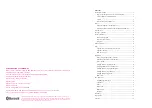
TAMC900 User Manual Issue 2.0.1
Page 17 of 71
4.2.1 Operation Modes (OM)
One operation mode is provided by the firmware (compare chapter “Trigger Configuration 0/1”) which allows
selecting which acquired ADC data should be transmitted via DMA. The different settings are explained
afterwards.
There is no absolute sample count that defines the end of transmission. This is performed until a descriptor
signalizes the end of the link list.
Due to the initially mentioned restriction the channels of a group are started together and a
channel of the group can be restarted first if all other channels of the group are in idle.
The
Post Trigger Data
Gathering
is the standard case. The ADC data obtained after a trigger impulse is used
for data transmission. Since the mode does not make use of previous data samples there are no restrictions
concerning the number of transmitted samples. The content of register “Channel Pre-Trigger Data Size” must
be zero (see below).
The
Pre Trigger Data
Gathering
is the opposite case. If a trigger event has been detected, the data that has
been monitored before its occurrence will be transmitted. For this, the content of the QDR-II memory is used.
Consequently, the number of samples cannot exceed the QDR-II memory depth. The value of register
“Channel Pre-Trigger Data Size” defines the transmission size. Moreover the linked list must match the
requested sample count (see below).
The
Around Trigger Data
Gathering
is a mixture of the previous two modes. It is used to obtain the data
before and after the trigger event. Thus it makes also use of the QDR-II memory. Hence it is subdued the
size limitation as the Pre-Trigger. The implementation is done in accordance to the above two methods. The
value of register “Channel Pre-Trigger Data Size” defines the demanded tracked samples as starting point.
Afterwards transmission is performed until the linked list has been finished by a descriptor.
Pre- and Around Trigger Data Gathering require some time between trigger events to monitor
ADC channel data. This time depends on the adjusted sample rate. If the inter trigger event
period is too short, it is possible that the transmitted sample data is invalid.
There are three external (physical) trigger sources that can be used. These are described in chapter “Trigger
Configuration 0/1”. For adaptation purposes the interpretation of a trigger input signal change (edge) can be
defined.
Currently only edge-evaluated trigger have been implemented. Level trigger are not
considered.
Besides the external trigger inputs a software trigger input can be selected. This make use of an additionally
register (see chapter “Global Reset and Software Trigger Input”) to initiate processing by writing at a certain
bit position.
All trigger inputs are handled in the same manner. There is no difference.
Additionally the Post Trigger Data gathering can be used in conjunction with the software trigger to realize a
free-running operation mode if necessary.
















































